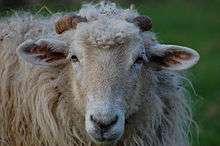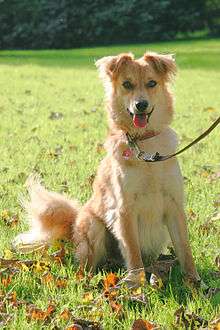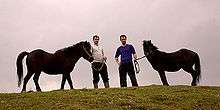Basque breeds and cultivars


There are a number of Basque breeds and cultivars. These are domesticated animals that have been bred - or plant species cultivated - for particular traits and features by Basque people in the Basque Country.
Some, such as the Alano Español, are not originally Basque but have only survived in the Basque Country.
Basque breeds
Azpi Gorri
The Azpi Gorri is a breed of goat found in the Gorbeia region between Álava and Biscay, the Encartaciones, Anboto and Aramotz in Biscay. With less than 100 animals, it is considered an endangered rare breed.[1]
Basco-béarnaise
The Basco-béarnaise (also encountered under the name Vasca Carranzana[2]) is a sheep breed from the Northern Basque Country and Béarn. Its characteristics are long, white wool, curved horns, weighing up to 80 kg. It is mainly a dairy sheep and the milk (7.42% fat content, 5.39% proteins) is used to make the AOC Ossau-Iraty cheese.
Basque Mountain Horse
Basque pig
The Basque pig, also called Pie Noir du Pays basque, Euskal Xerria or Xuri eta beltza, is an indigenous breed of the Basque Country, standardized in France in 1921, and today endangered.
Basque Shepherd Dog

The Basque Shepherd Dog (pastor vasco in Spanish, artzain txakurra in Basque) is a dog breed common throughout the Basque Country.
Betizu
The Betizu is a cattle breed characterised as being agile, with a large head and a rectangular profile.
Burguete horse
Enkarterriko Asto
The Enkarterriko Asto or Spanish: Asno de las Encartaciones is the smallest Iberian donkey breed with males weighing between 170 kg to 210 kg and females 140–190 kg and not much taller than 120 cm.
Euskal Antzara
The Euskal Antzara is the Basque breed of domestic goose. It is raised for both meat and eggs. Ganders weigh 7–9 kg, geese about 1 kg less. The eggs are white and weigh at least 160 g.[3]:610–11
Euskal Oiloa
The Euskal Oiloa is the chicken breed of the Basque Country. It has five varieties: Beltza (black), Gorria, Lepasoila (naked-necked), Marraduna and Zilarra.[3]:632–34 At the end of 2013 a population of 10,872 birds was reported, all from the País Vasco.[4]
Jaca Navarra
Latxa

The Latxa ([ˈlatʃa]), also encountered as lacha in the Spanish spelling is a Basque dairy sheep. They are mostly bred in Biscay, Gipuzkoa and Navarre for their milk which is used in the production of Idiazábal and Roncal cheeses.
A medium to small sheep with a fairly coarse wool.
Pottoka

The Pottoka (Basque pronunciation: [poˈcoka]) is an ancient but endangered breed of mountain horse. They are small horses with a large head, small ears, short neck, long back, shaggy mane and small hooves. Originally these roamed the Basque Pyrenees in a semi-feral state but today many are stabled.
Pyrenean Mountain Dog
The Pyrenean Mountain Dog (Pirinioetako mendiko zakurra in Basque) is a large breed of dog used as a livestock guardian dog.
Basque cultivars
Alubia pinta alavesa

The Alavan pinto bean is a type of common bean.
Basque apple cultivars
Apple growing has a long history in the Basque Country, in particular for use in making Basque cider. The earliest written records on cider making and drinking go back to the 11th and 12th century, the very first being a record of Sancho III of Navarre sending an envoy to the Monastery of Leire in 1014 who mentions apples and cider-making. The other is the circa 1134 diary of the pilgrim Aymeric Picaud included in the Codex Calixtinus who mentions the Basques being notable for growing apples and drinking cider. The 16th century inquisitor Pierre de Lancre also refers to the Basque Country as "the land of the apple".
Many varieties exist and are used for making cider. Azkue's dictionary alone, which was printed in 1905, lists more than 80 Basque varieties of apples.[5] Depending on the desired character of the finished cider, different varieties and proportions of apple varieties are used. Some common varieties include:
- Errezila, sharp and sweet (mottled green), the most common Basque apple variety
- Geza miña, sharp; also called sagar zuria and esnaola sagarra (green)
- Goikoetxea, sharp (red)
- Mokoa, sharp (red)
- Mozoloa sweet and fresh (green)
- Patzuloa, sweet and fresh (light green)
- Txalaka sour and sweet (bright green)
- Ugarte, sour (red)
- Urdin sagarra, sharp (apple red on top and green underneath)
- Urtebi txikia, sharp (yellow-green)
Espelette peppers
A variety of mild peppers with AOC certification, grown in the Northern Basque Country in the Espelette area.
Pelua cherries
Pelua cherries are an early Basque black cherry cultivar.[6]
Xapata cherries
Xapata (pronounced [ʃaˈpata]) cherries are a variety of black cherry with a very short fruiting season, lasting only a few weeks around June. They are cultivates mainly in the area around the Lapurdian town of Itxassou.[7]
Pyrenean breeds
Several breeds of animals are common both in the Basque Country and other regions straddling the Pyrenees.
Pirenaica
The Pirenaica is a breed of cattle found in the Basque Country, Aragon and Catalonia. There were more than 4000 Pirenaicas in the Basque Autonomous Community in 1995 and the breed is not considered endangered.[8]
See also
References
- ↑ Euskal Abereak Society for Basque Breeds, retrieved 16.11.2009
- ↑ Desilva, U. & Fitch, J. Breeds of Livestock "Archived copy". Archived from the original on 2008-09-07. Retrieved 2009-05-15. retrieved 15.05.2009
- 1 2 Miguel Fernández Rodríguez, Mariano Gómez Fernández, Juan Vicente Delgado Bermejo, Silvia Adán Belmonte, Miguel Jiménez Cabras (eds.) (2009). Guía de campo de las razas autóctonas españolas (in Spanish). Madrid: Ministerio de Medio Ambiente y Medio Rural y Marino. ISBN 9788449109461.
- ↑ Raza aviar EUSKAL OILOA: Datos Censales (in Spanish). Ministerio de Agricultura, Alimentación y Medio Ambiente. Accessed September 2014.
- ↑ Azkue, RM. Diccionario Vasco-Español-Francés 1905
- ↑ Arbelbide, N. Gorri, lodi, azukretsu, txiki, beltz... Berria: 2006 "Archived copy". Archived from the original on 2011-07-16. Retrieved 2009-11-15. Retrieved 12.11.2009
- ↑ Kurlansky, M. The Basque History of the World Vintage: 2000 ISBN 0-09-928413-8
- ↑ Nekanet "Archived copy". Archived from the original on 2010-01-27. Retrieved 2009-11-16. Agricultural Network of the Basque Country, retrieved 16.11.2009